Experimental Study on Horizontal Cylinders with Triangular Fins under Natural Convection
Abstract
:1. Introduction
2. Experimental Procedure
3. Results and Discussion
4. Conclusions
Acknowledgments
Author Contributions
Conflicts of Interest
Appendix A. Uncertainty Analysis
Appendix B. Efficiency of a Triangular Fin

References
- Oktay, S.; Hannemann, R.J.; Bar-Cohen, A. High Heat from a Small Package. Mech. Eng. 1986, 108, 36–42. [Google Scholar]
- Bar-Cohen, A. Thermal Management of Electric Components with Dielectric Liquids. JSME Int. J. Ser. B Fluids Therm. Eng. 1993, 36, 1–25. [Google Scholar] [CrossRef]
- Park, J.; Shin, M.; Lee, C.C. Measurement of Temperature Profiles on Visible Light-emitting Diodes by Use of a Nematic Liquid Crystal and an Infrared Laser. Opt. Lett. 2004, 29, 2656–2658. [Google Scholar] [CrossRef] [PubMed]
- Narendran, N.; Gu, Y. Life of LED-based White Light Sources. J. Disp. Technol. 2005, 1, 167–171. [Google Scholar] [CrossRef]
- Liu, J.; Tam, W.S.; Wong, H.; Filip, V. Temperature-dependent Light-Emitting Characteristics of InGaN/GaN Diodes. Microelectron. Reliab. 2009, 49, 38–41. [Google Scholar] [CrossRef]
- Chang, M.-H.; Das, D.; Varde, P.V.; Pecht, M. Light Emitting Diodes Reliability Review. Microelectron. Reliab. 2012, 52, 762–782. [Google Scholar] [CrossRef]
- Lasance, C.J.M.; Poppe, A. (Eds.) Thermal Management for LED Applications; Springer: New York, NY, USA, 2014. [Google Scholar]
- Nakayama, W. Thermal Management of Electronic Equipment: A Review of Technology and Research Topics. Appl. Mech. Rev. 1986, 39, 1847–1868. [Google Scholar] [CrossRef]
- Incropera, F.P. Convection Heat Transfer in Electronic Equipment Cooling. J. Heat Transf. 1988, 110, 1097–1111. [Google Scholar] [CrossRef]
- Sparrow, E.M.; Bahrami, P.A. Experiments on Natural Convection Heat Transfer on the Fins of a Finned Horizontal Tube. Int. J. Heat Mass Transf. 1980, 23, 1555–1560. [Google Scholar] [CrossRef]
- Chen, H.-T.; Chou, J.-C. Investigation of Natural-Convection Heat Transfer Coefficient on a Vertical Square Fin of Finned-Tube Heat Exchangers. Int. J. Heat Mass Transf. 2006, 49, 3034–3044. [Google Scholar] [CrossRef]
- Yildiz, Ş.; Yüncü, H. An Experimental Investigation on Performance of Annular Fins on a Horizontal Cylinder in Free Convection Heat Transfer. Heat Mass Transf. 2004, 40, 239–251. [Google Scholar] [CrossRef]
- Hahne, E.; Zhu, D. Natural Convection Heat Transfer on Finned Tubes in Air. Int. J. Heat Mass Transf. 1994, 37, 59–63. [Google Scholar] [CrossRef]
- Kim, H.J.; An, B.H.; Park, J.; Kim, D.K. Experimental study on natural convection heat transfer from horizontal cylinders with longitudinal plate fins. J. Mech. Sci. Technol. 2013, 27, 593–599. [Google Scholar] [CrossRef]
- Jang, D.; Park, S.J.; Yook, S.J.; Lee, K.S. The orientation effect for cylindrical heat sinks with application to LED light bulbs. Int. J. Heat Mass Transf. 2014, 71, 496–502. [Google Scholar] [CrossRef]
- Jang, D.; Kim, D.R.; Lee, K.-S. Correlation of Cross-cut Cylindrical Heat Sink to Improve the Orientation Effect of LED Light Bulbs. Int. J. Heat Mass Transf. 2015, 84, 821–826. [Google Scholar] [CrossRef]
- Kwak, D.B.; Noh, J.H.; Lee, K.S.; Yook, S.J. Cooling performance of a radial heat sink with triangular fins on a circular base at various installation angles. Int. J. Therm. Sci. 2017, 120, 377–385. [Google Scholar] [CrossRef]
- Lee, M.; Kim, H.J.; Kim, D.-K. Nusselt Number Correlation for Natural Convection from Vertical Cylinders with Triangular Fins. Appl. Therm. Eng. 2016, 93, 1238–1247. [Google Scholar] [CrossRef]
- Kang, B.D.; Kim, H.J.; Kim, D.K. Nusselt Number Correlation for Vertical Tubes with Inverted Triangular Fins under Natural Convection. Energies 2017, 10, 1183. [Google Scholar] [CrossRef]
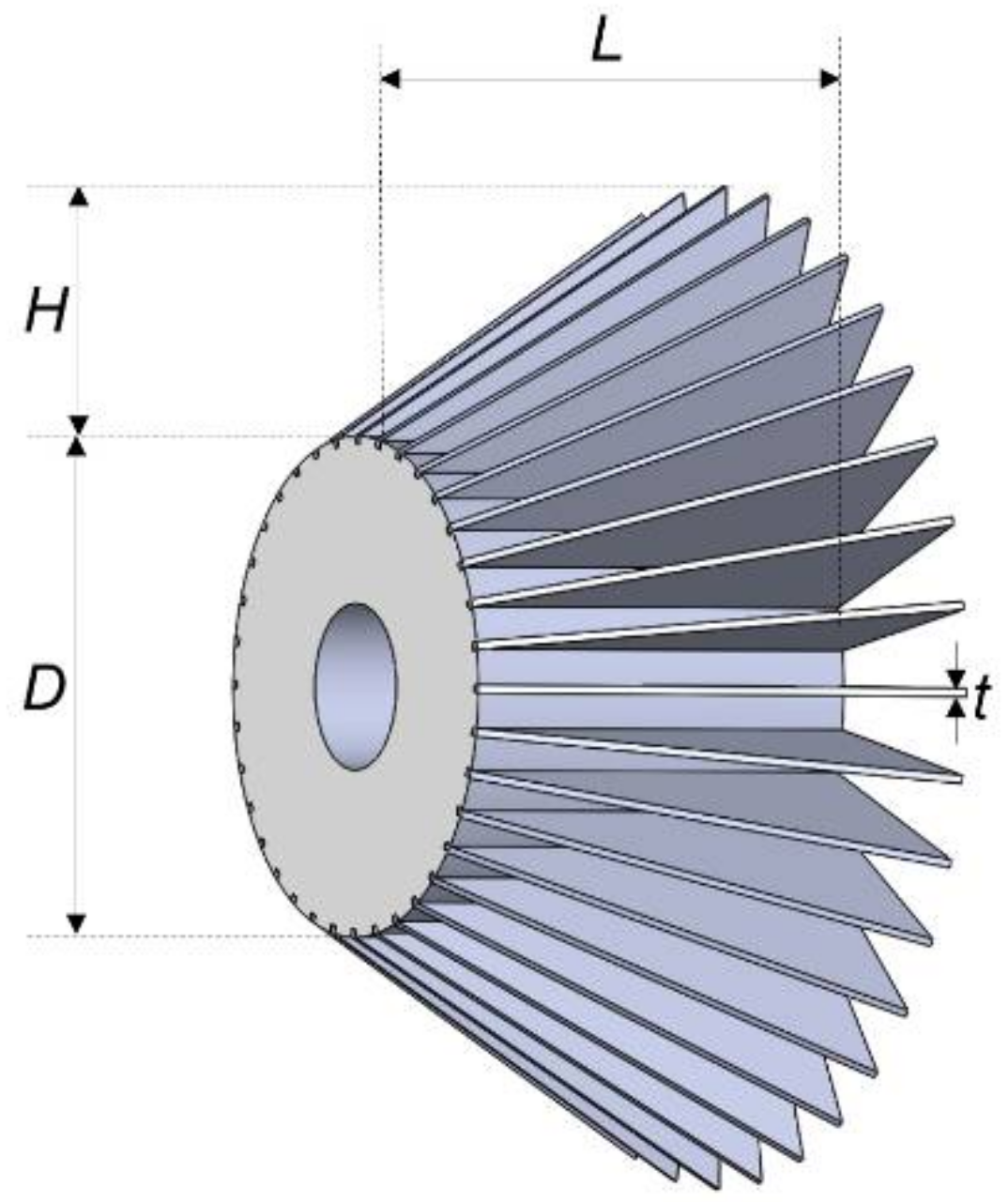
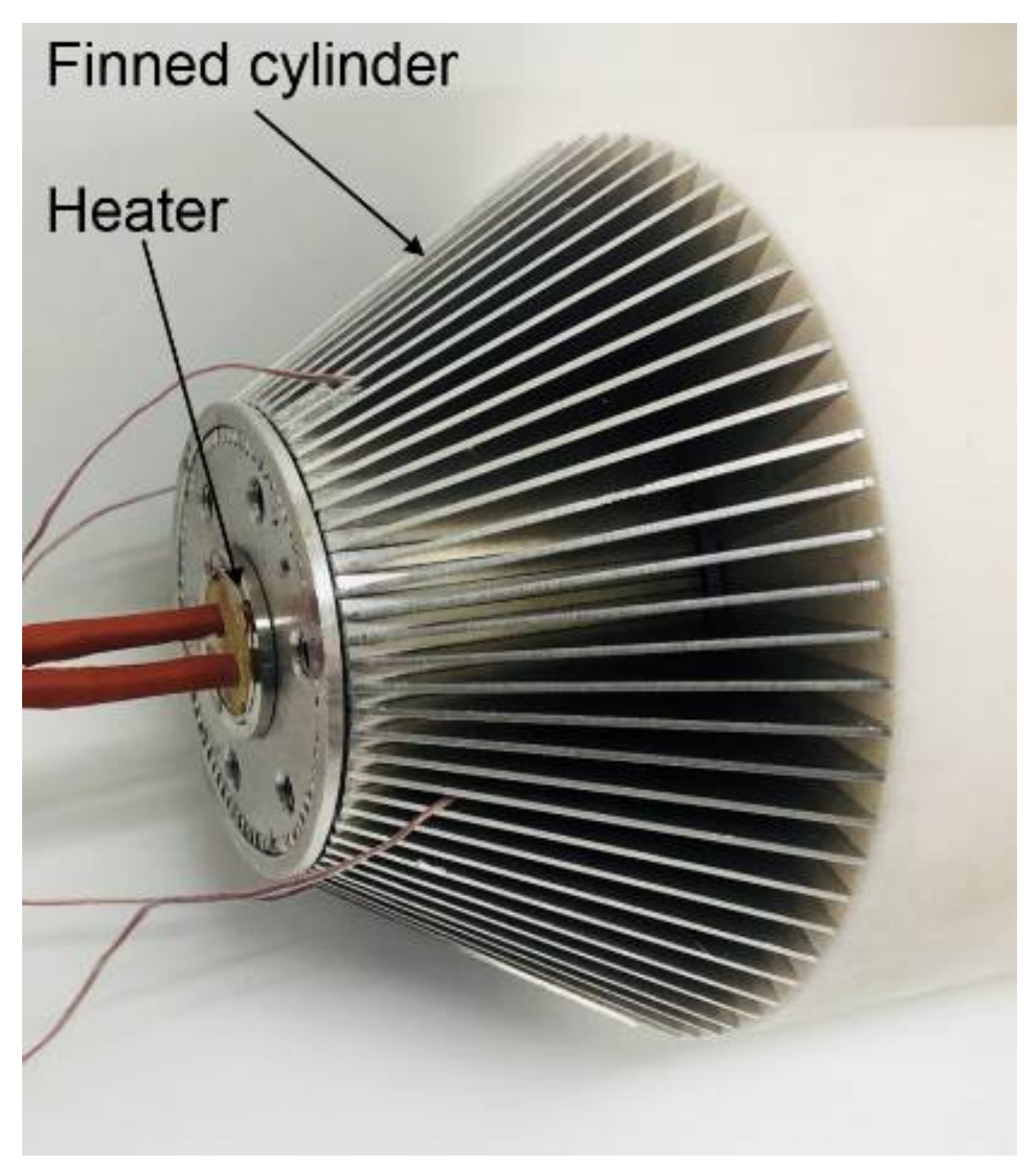
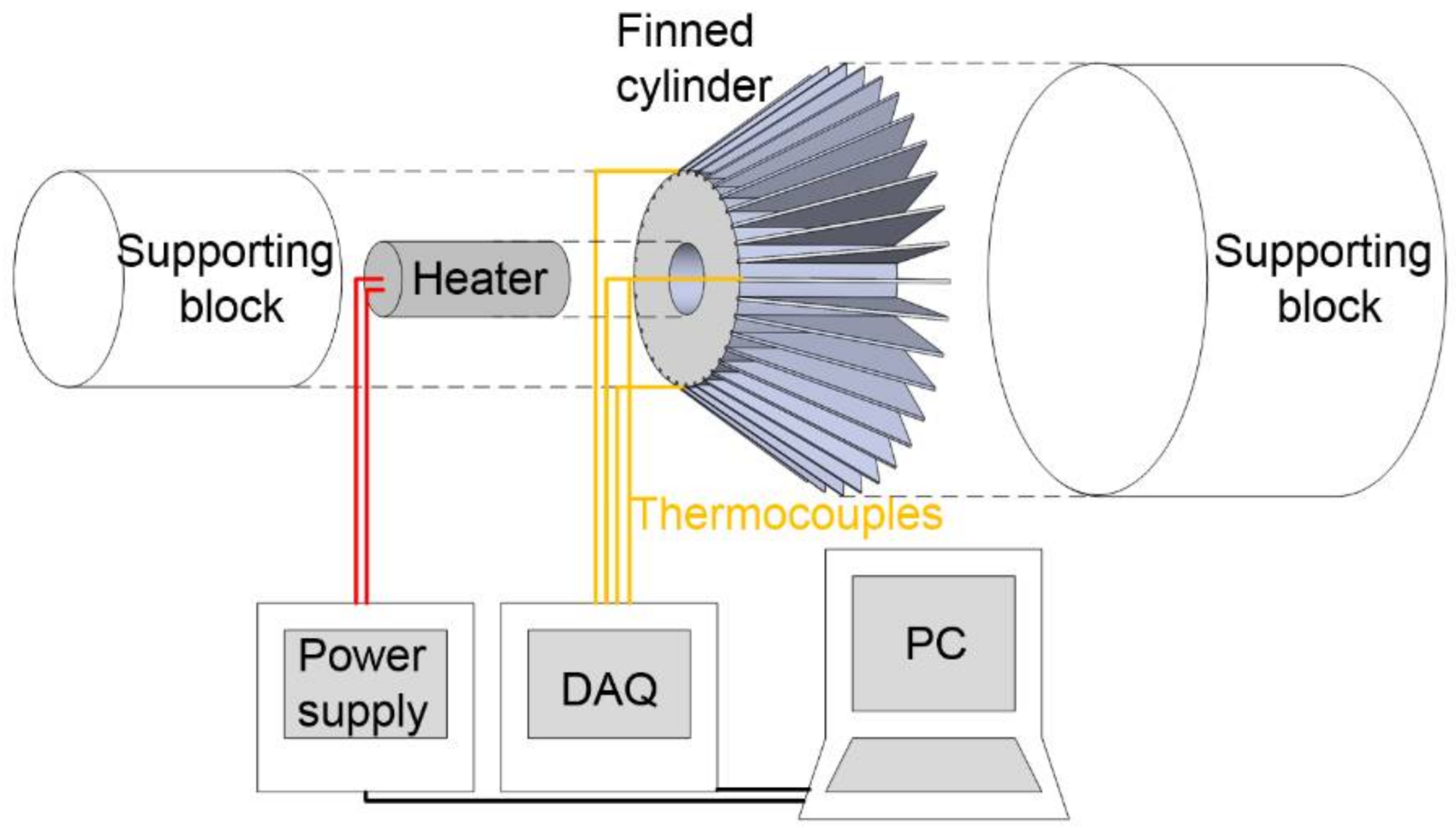
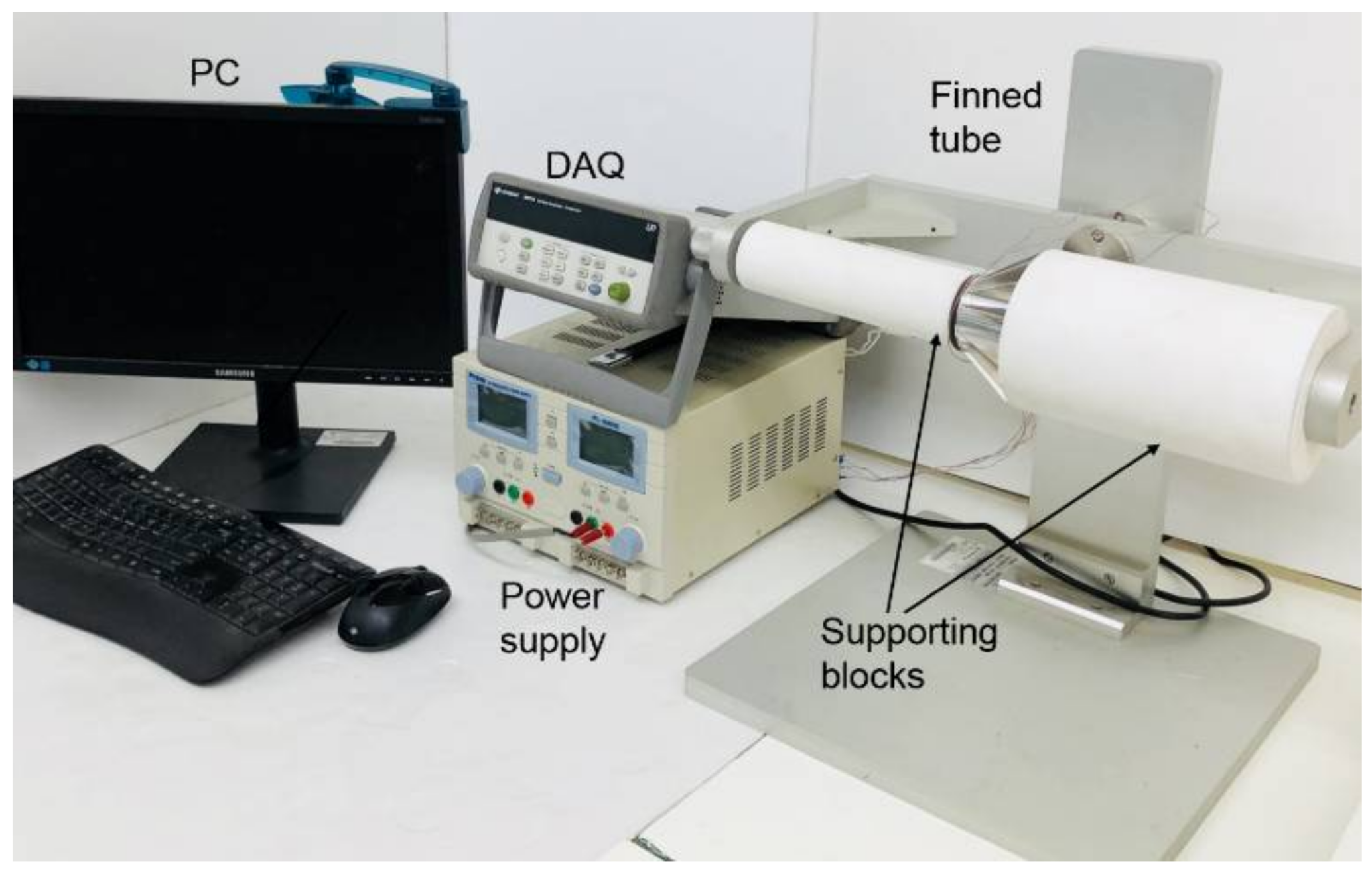
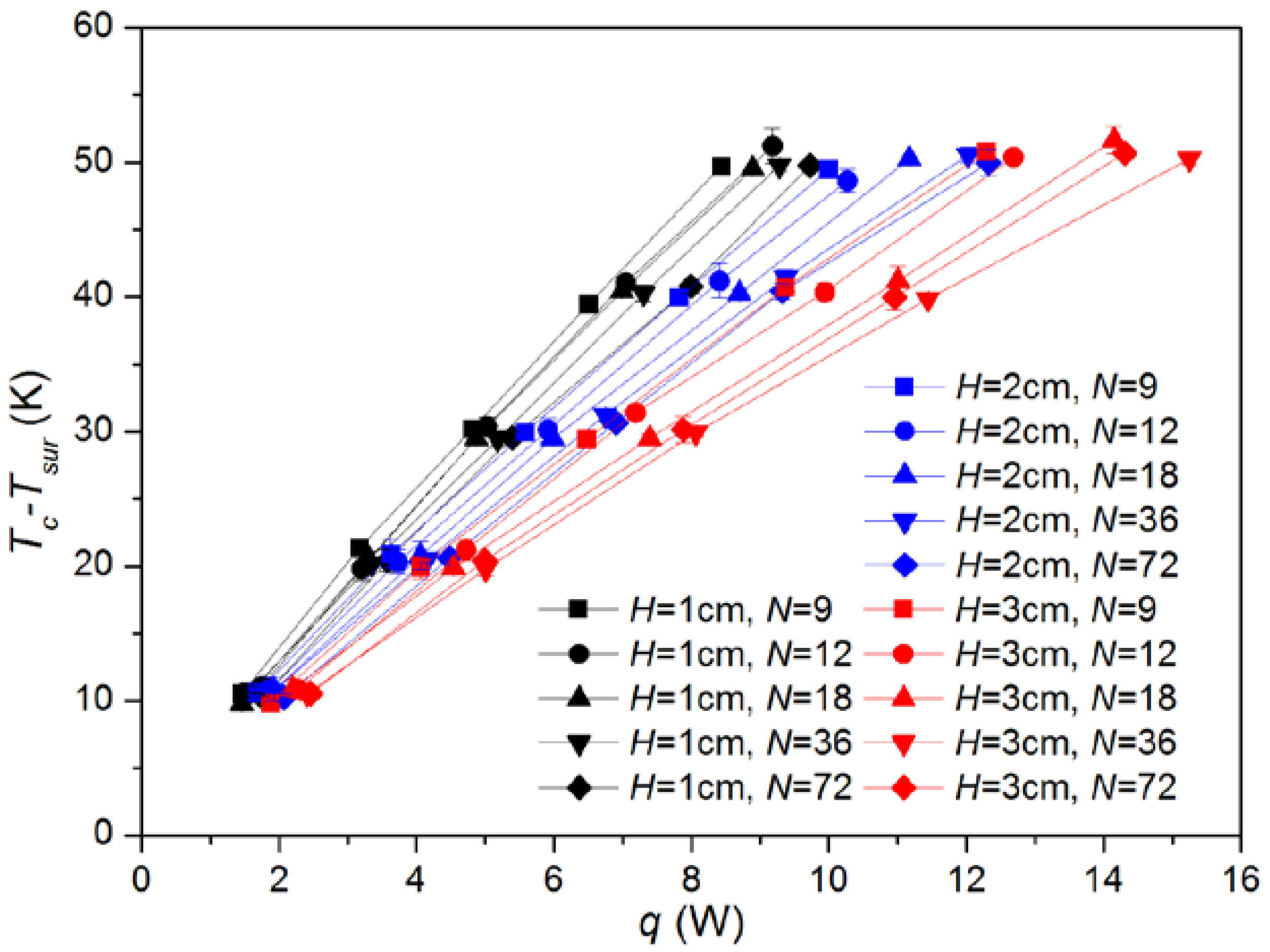
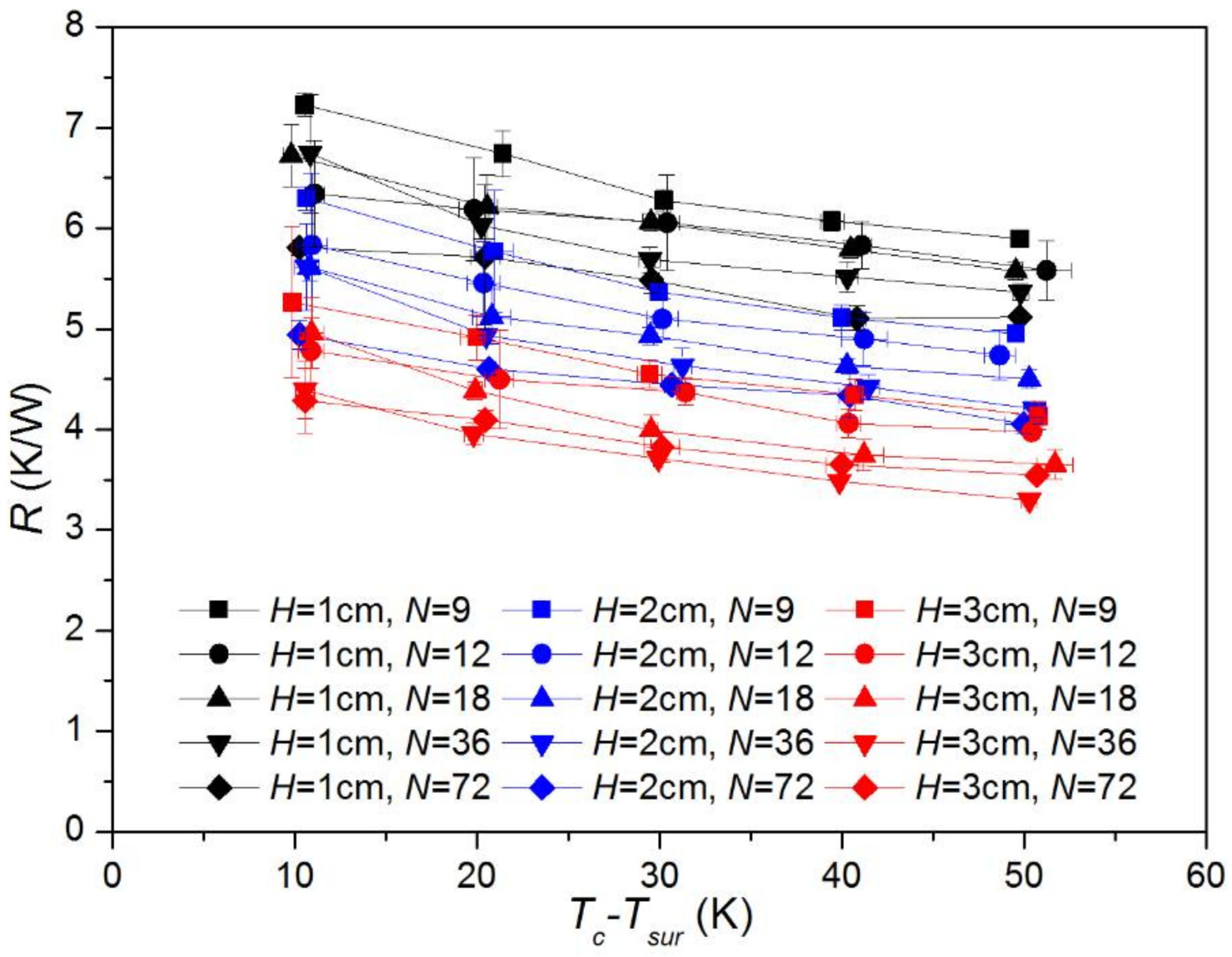
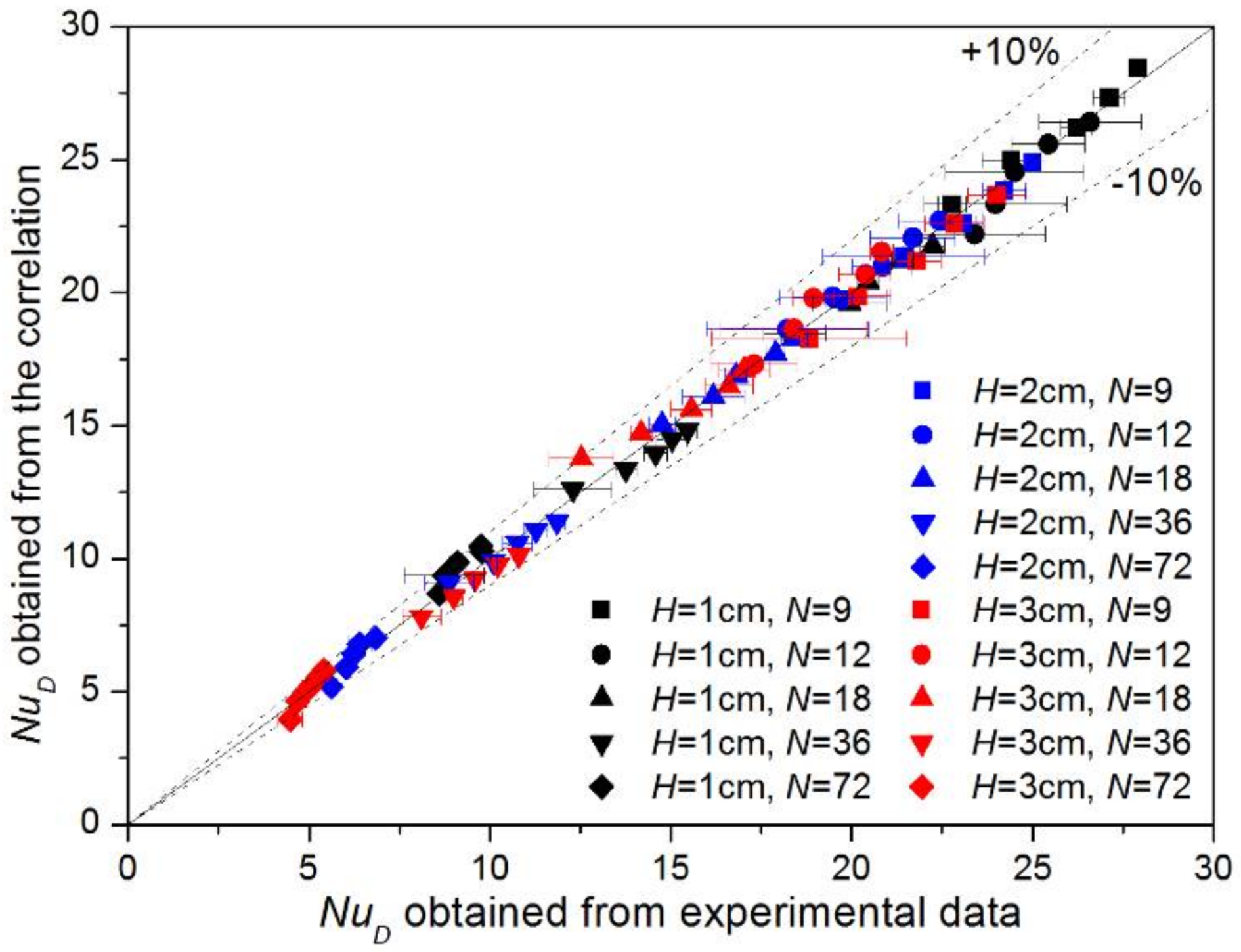
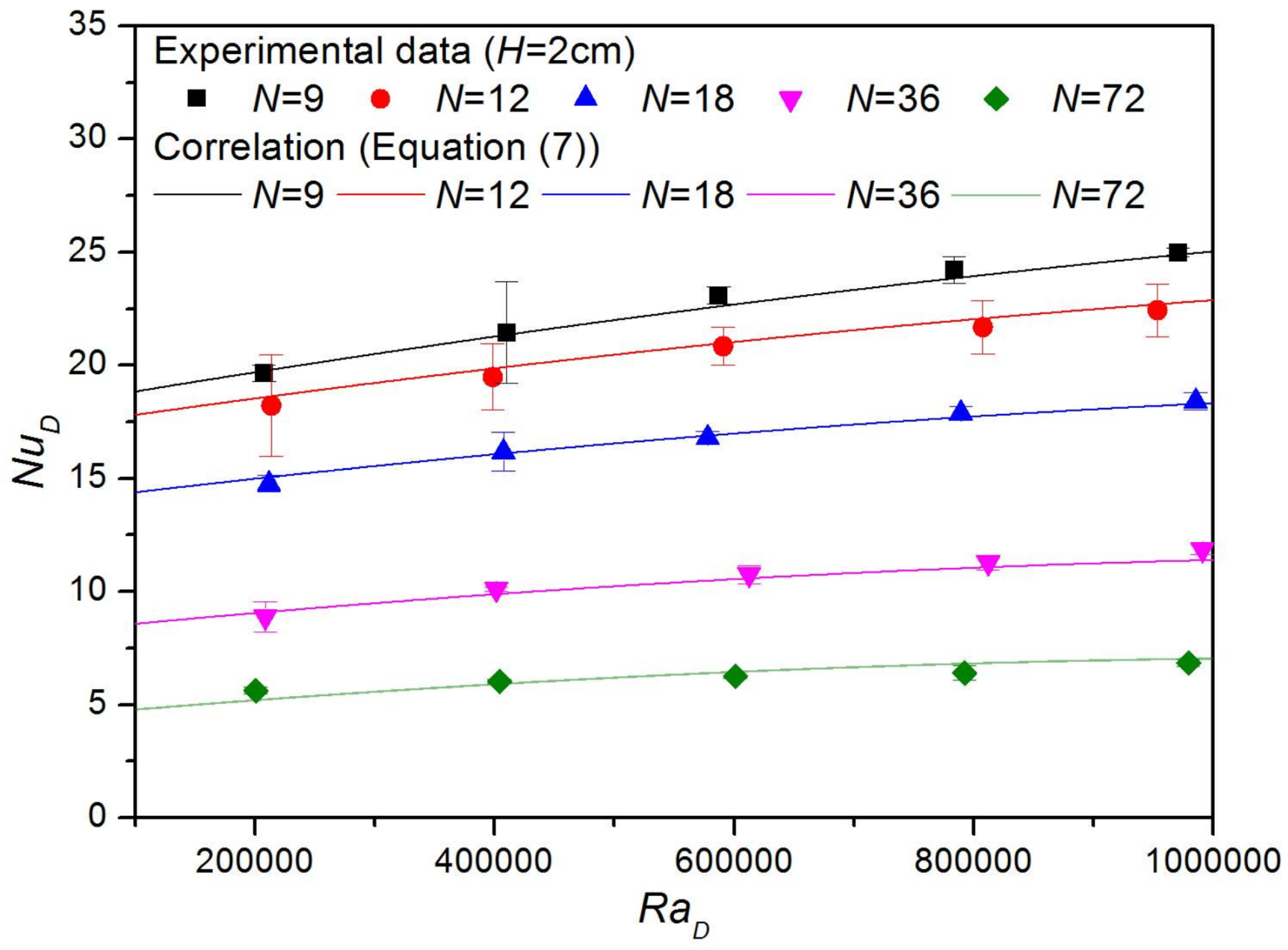
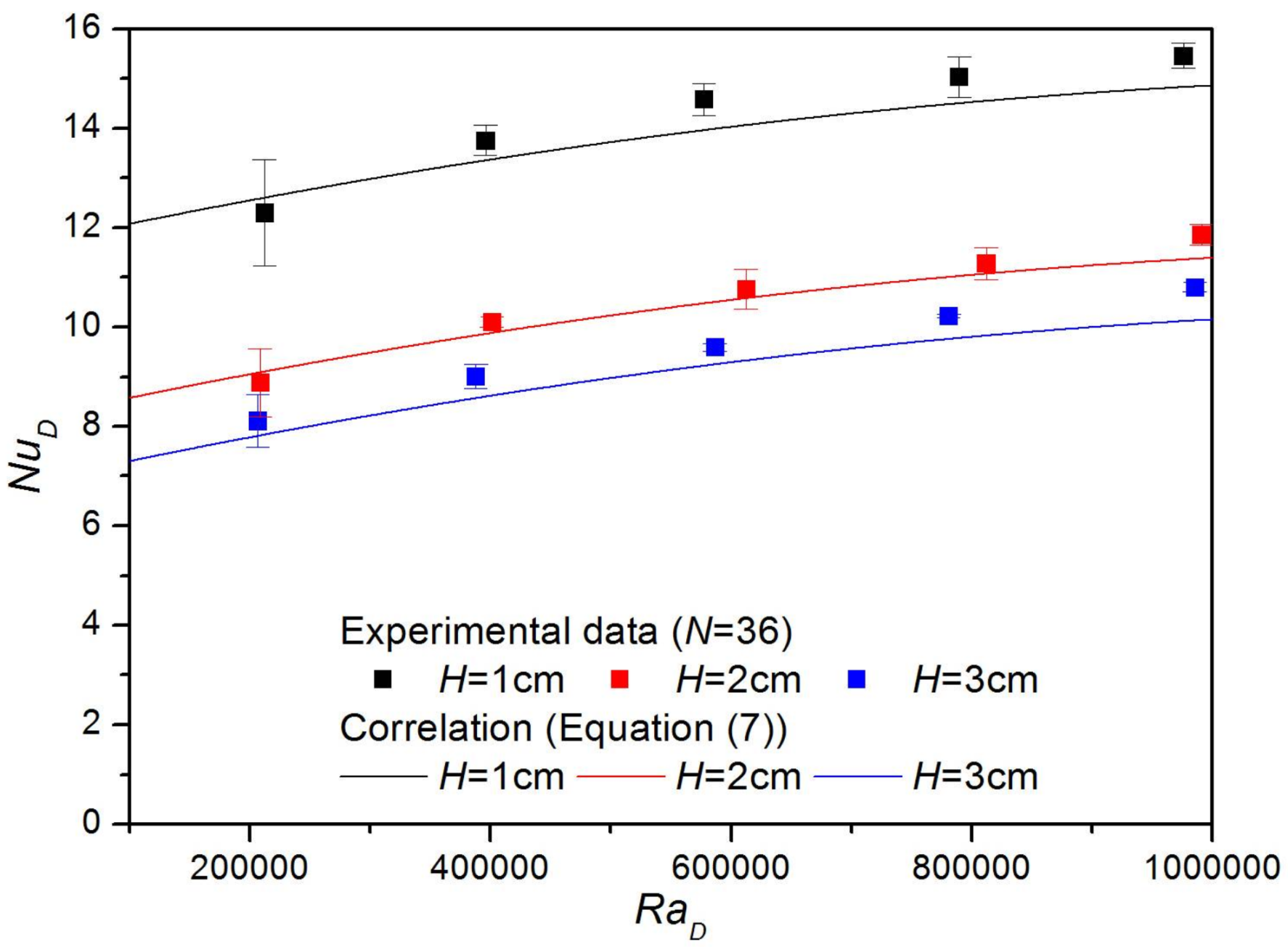
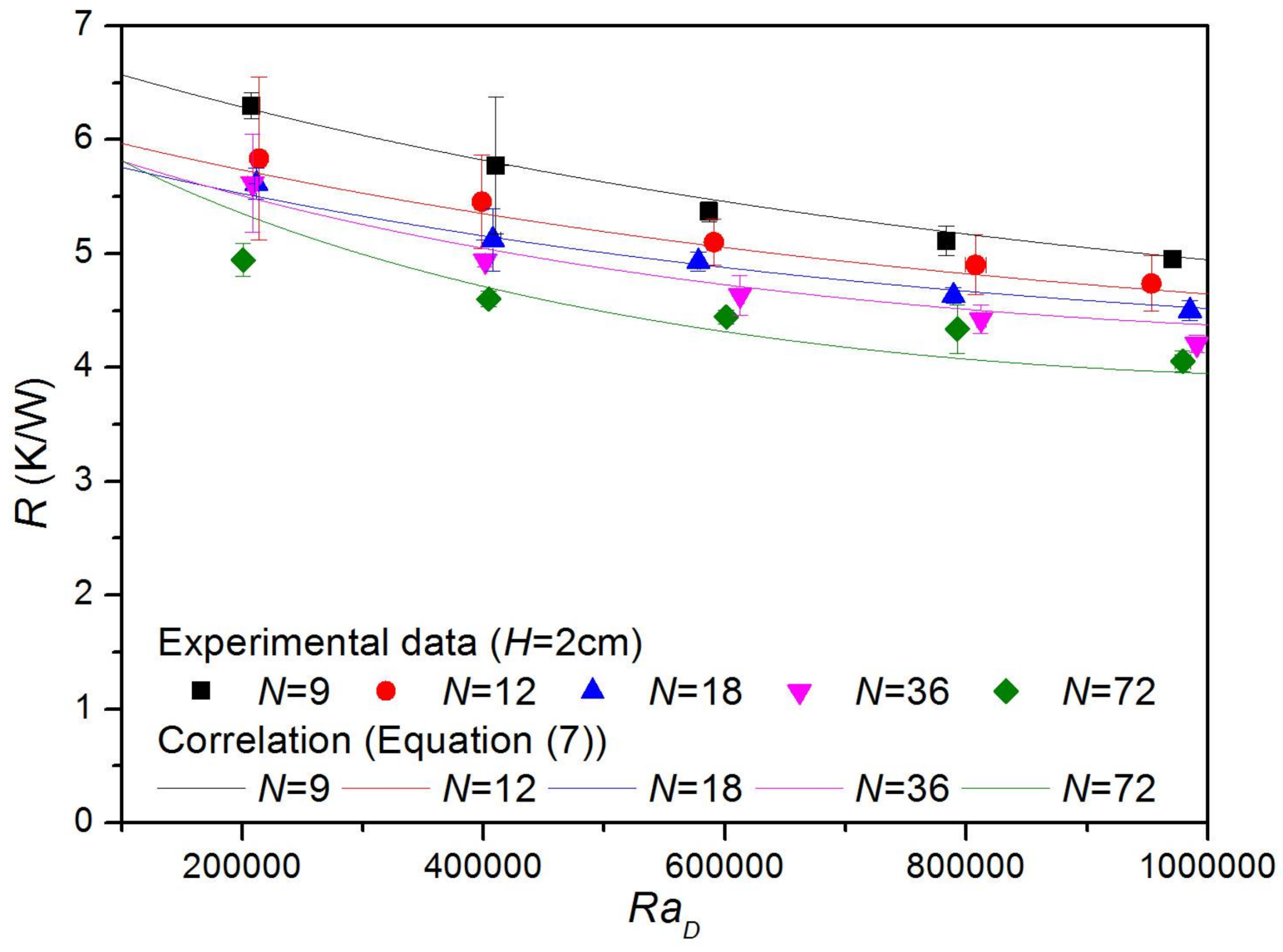
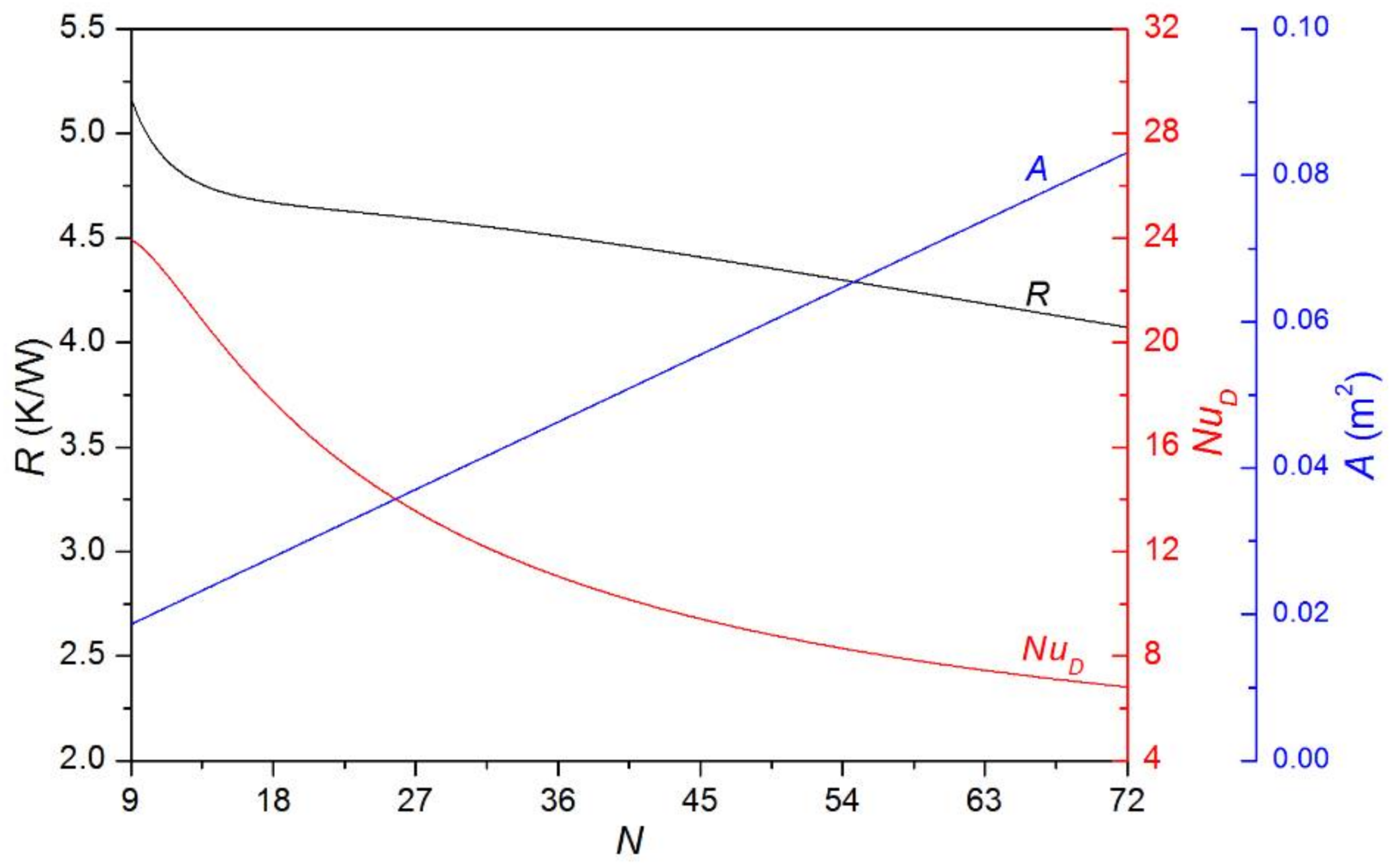
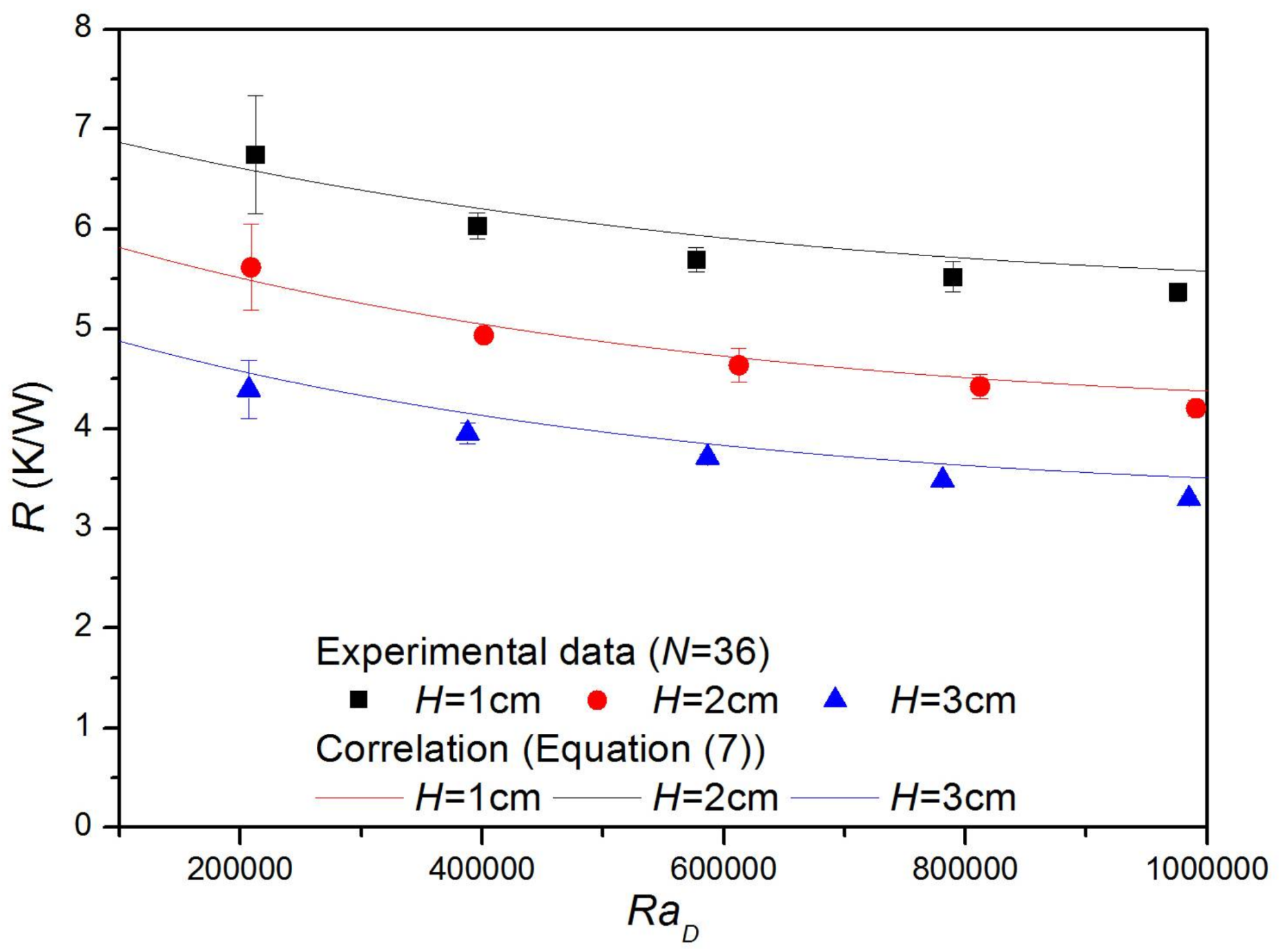
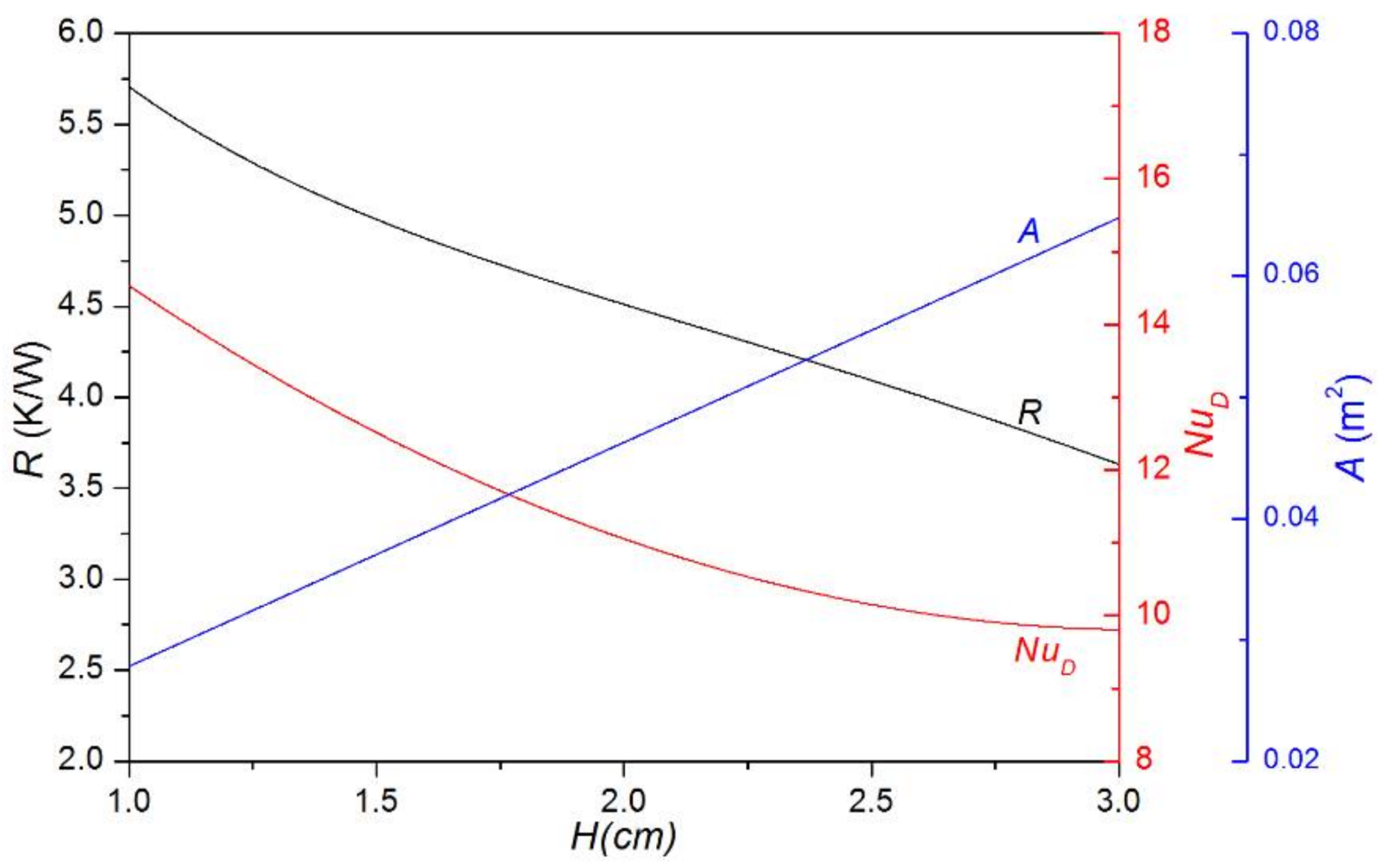
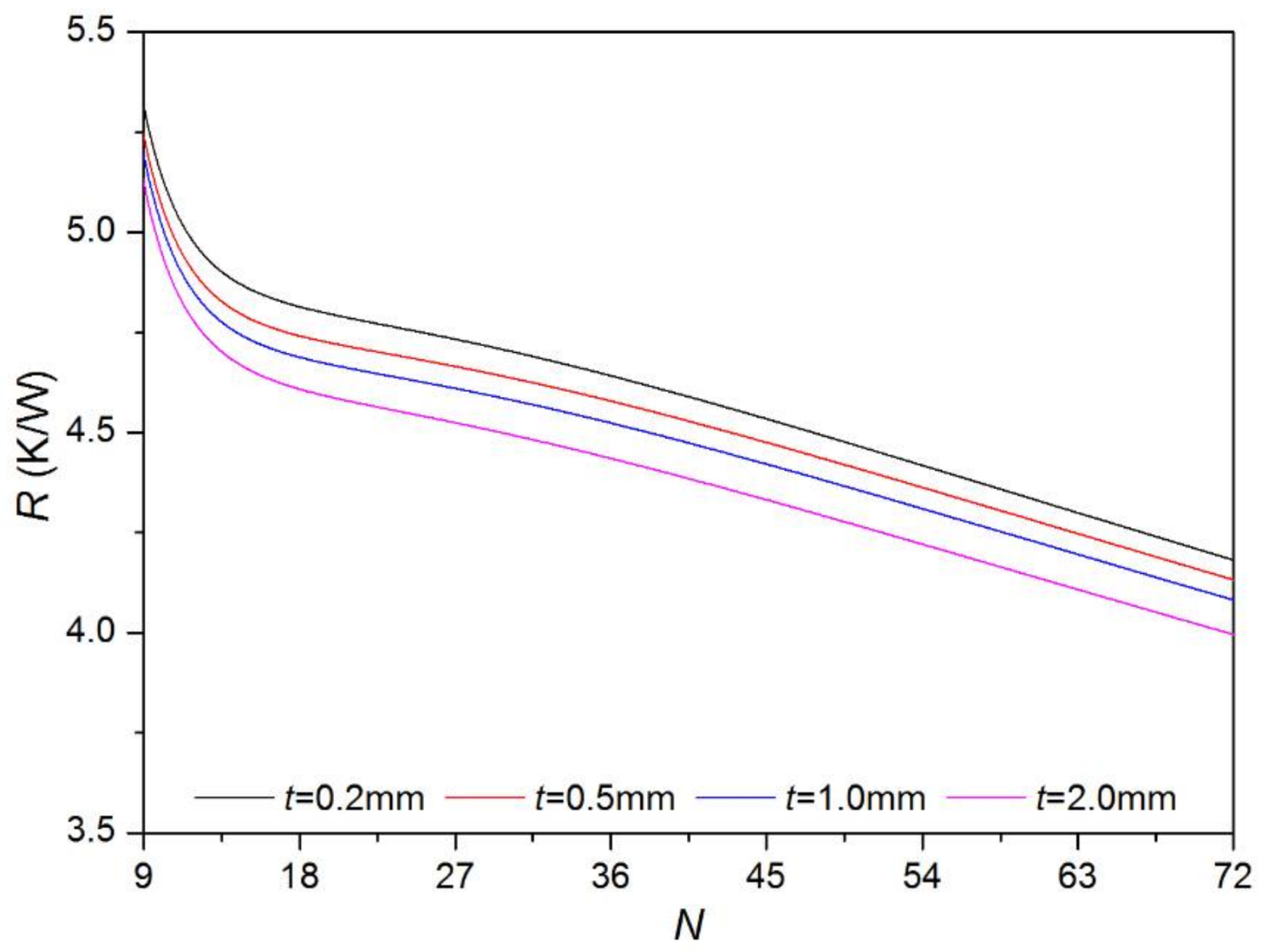

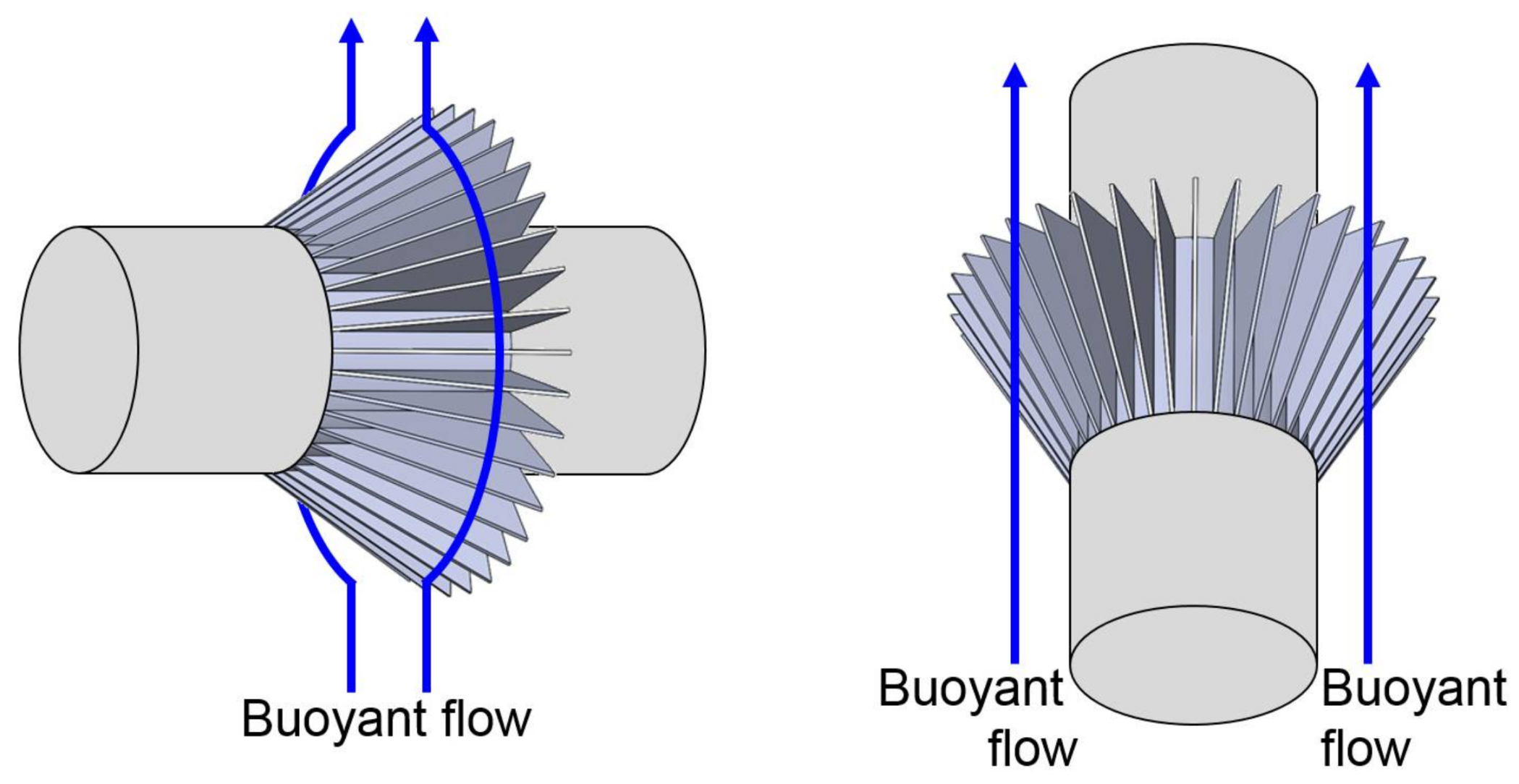
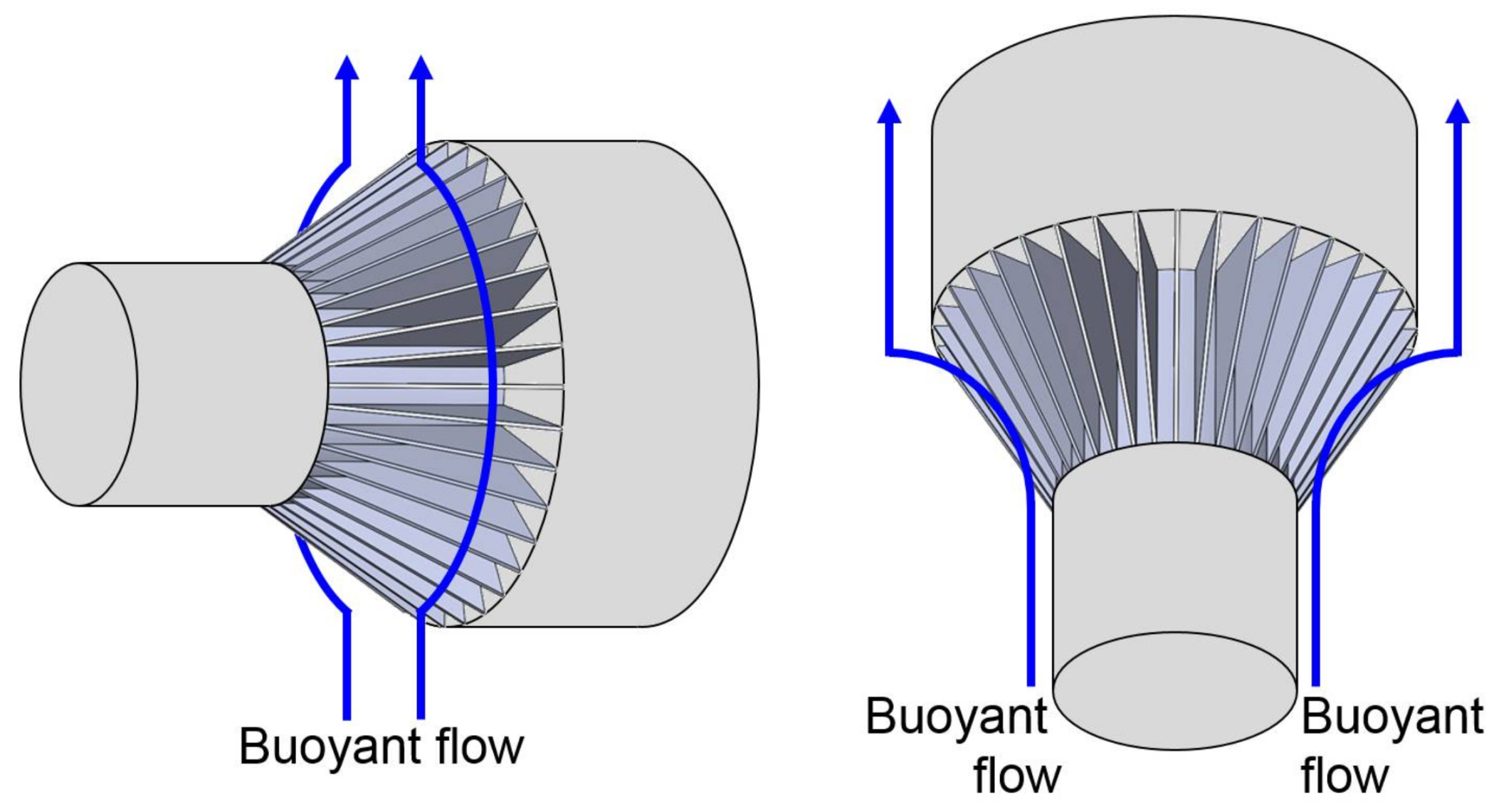
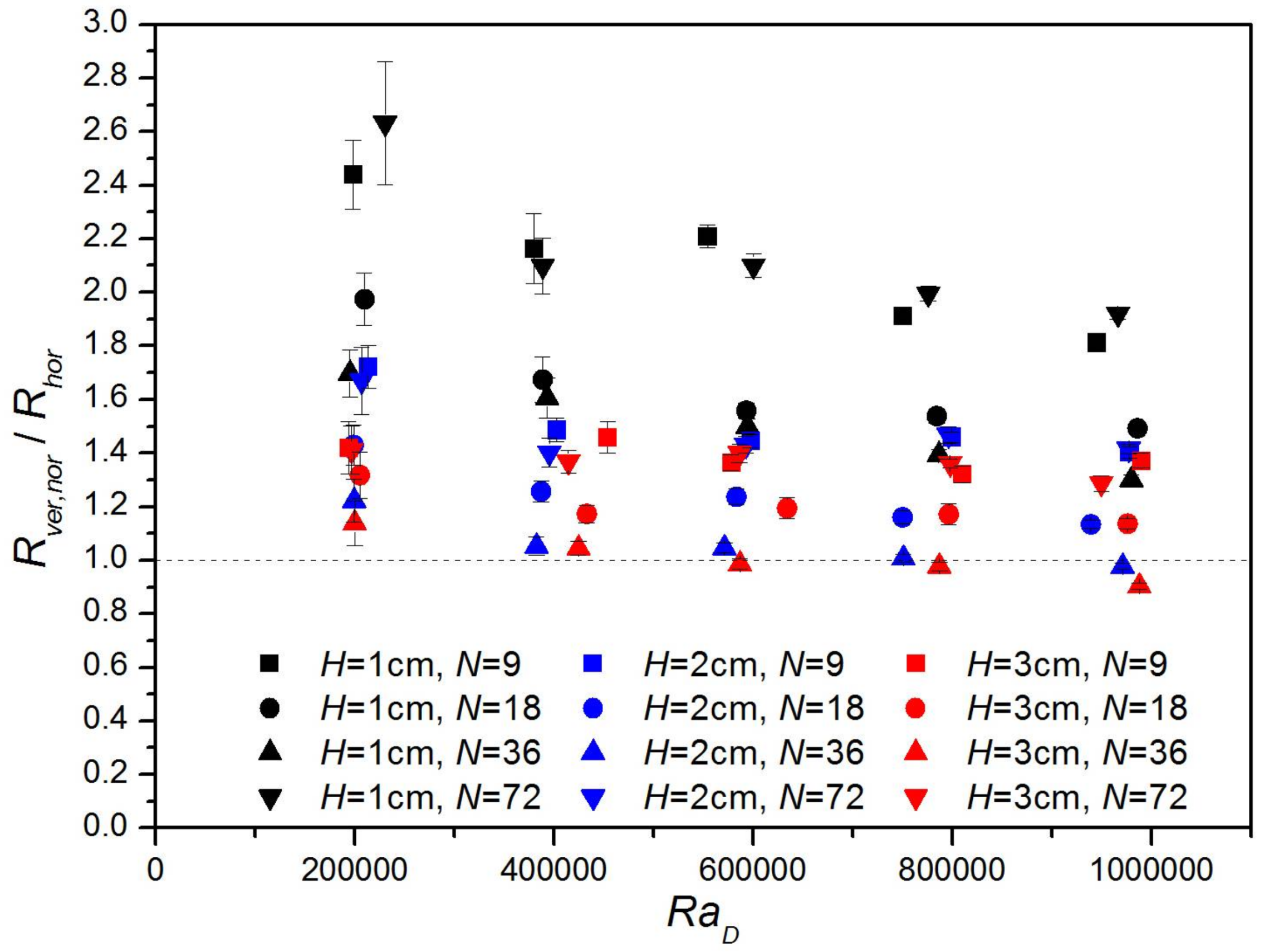
| Extended Surface Type | Authors | Summary |
|---|---|---|
| Vertical square plates | Sparrow and Bahrami [10] |
|
| Chen and Chou [11] |
| |
| Vertical annular plates | Yildiz and Yüncü [12] |
|
| Hahne and Zhu [13] |
| |
| Radial rectangular plates | Kim et al. [14] |
|
| Jang et al. [15] |
| |
| Radial cross-cut plates | Jang et al. [16] |
|
| Radial triangular plates | Kwak et al. [17] |
|
| Fin Number (N) | Fin Height (H) | Other Dimensions |
|---|---|---|
| 9 12 18 36 72 | 1 cm 2 cm 3 cm | D = 6 cm L = 5 cm t = 1 mm |
| N | H | q (W) | Tc − Tsur (K) | R (K/W) | NuD |
|---|---|---|---|---|---|
| 9 | 1 cm | 1.46 ± 0.01 | 10.5 ± 0.2 | 7.23 ± 0.12 | 22.77 ± 0.37 |
| 3.17 ± 0.04 | 21.4 ± 0.4 | 6.74 ± 0.23 | 24.41 ± 0.82 | ||
| 4.82 ± 0.01 | 30.2 ± 0.5 | 6.28 ± 0.10 | 26.22 ± 0.44 | ||
| 6.50 ± 0.01 | 39.5 ± 0.6 | 6.07 ± 0.10 | 27.11 ± 0.45 | ||
| 8.44 ± 0.01 | 49.7 ± 0.2 | 5.90 ± 0.02 | 27.91 ± 0.10 | ||
| 12 | 1 cm | 1.75 ± 0.06 | 11.1 ± 0.6 | 6.34 ± 0.53 | 23.39 ± 1.95 |
| 3.20 ± 0.11 | 19.8 ± 0.9 | 6.19 ± 0.51 | 23.97 ± 1.98 | ||
| 5.02 ± 0.18 | 30.4 ± 0.7 | 6.06 ± 0.47 | 24.50 ± 1.91 | ||
| 7.04 ± 0.13 | 41.1 ± 0.5 | 5.83 ± 0.23 | 25.44 ± 1.02 | ||
| 9.18 ± 0.22 | 51.2 ± 1.3 | 5.58 ± 0.3 | 26.59 ± 1.42 | ||
| 18 | 1 cm | 1.46 ± 0.01 | 9.80 ± 0.5 | 6.72 ± 0.31 | 18.43 ± 0.86 |
| 3.31 ± 0.07 | 20.5 ± 0.6 | 6.21 ± 0.32 | 19.95 ± 1.02 | ||
| 4.87 ± 0.01 | 29.5 ± 0.4 | 6.06 ± 0.09 | 20.45 ± 0.30 | ||
| 6.99 ± 0.04 | 40.5 ± 0.4 | 5.79 ± 0.08 | 21.41 ± 0.30 | ||
| 8.89 ± 0.07 | 49.5 ± 0.1 | 5.57 ± 0.08 | 22.24 ± 0.33 | ||
| 36 | 1 cm | 1.61 ± 0.07 | 10.8 ± 0.3 | 6.74 ± 0.59 | 12.30 ± 1.07 |
| 3.35 ± 0.03 | 20.2 ± 0.3 | 6.03 ± 0.13 | 13.76 ± 0.30 | ||
| 5.18 ± 0.03 | 29.5 ± 0.6 | 5.69 ± 0.13 | 14.58 ± 0.32 | ||
| 7.30 ± 0.09 | 40.3 ± 0.6 | 5.52 ± 0.15 | 15.03 ± 0.41 | ||
| 9.28 ± 0.07 | 49.8 ± 0.4 | 5.37 ± 0.09 | 15.46 ± 0.25 | ||
| 72 | 1 cm | 1.76 ± 0.01 | 10.2 ± 0.1 | 5.81 ± 0.08 | 8.59 ± 0.11 |
| 3.57 ± 0.23 | 20.4 ± 0.8 | 5.71 ± 0.72 | 8.74 ± 1.10 | ||
| 5.39 ± 0.05 | 29.6 ± 0.4 | 5.48 ± 0.13 | 9.11 ± 0.21 | ||
| 7.99 ± 0.09 | 40.8 ± 0.5 | 5.11 ± 0.12 | 9.78 ± 0.23 | ||
| 9.72 ± 0.05 | 49.8 ± 0.3 | 5.12 ± 0.05 | 9.75 ± 0.10 | ||
| 9 | 2 cm | 1.68 ± 0.01 | 10.6 ± 0.2 | 6.30 ± 0.12 | 19.65 ± 0.36 |
| 3.63 ± 0.17 | 20.9 ± 1.0 | 5.77 ± 0.6 | 21.45 ± 2.24 | ||
| 5.58 ± 0.01 | 29.9 ± 0.5 | 5.37 ± 0.09 | 23.07 ± 0.38 | ||
| 7.82 ± 0.10 | 40.0 ± 0.2 | 5.11 ± 0.13 | 24.22 ± 0.60 | ||
| 10.0 ± 0.01 | 49.5 ± 0.4 | 4.95 ± 0.04 | 25.00 ± 0.19 | ||
| 12 | 2 cm | 1.87 ± 0.10 | 10.9 ± 0.8 | 5.83 ± 0.72 | 18.22 ± 2.24 |
| 3.73 ± 0.12 | 20.3 ± 0.9 | 5.46 ± 0.41 | 19.48 ± 1.47 | ||
| 5.91 ± 0.09 | 30.1 ± 0.9 | 5.10 ± 0.2 | 20.84 ± 0.83 | ||
| 8.41 ± 0.21 | 41.2 ± 1.3 | 4.90 ± 0.26 | 21.69 ± 1.17 | ||
| 10.3 ± 0.29 | 48.6 ± 0.9 | 4.74 ± 0.24 | 22.44 ± 1.16 | ||
| 18 | 2 cm | 1.93 ± 0.01 | 10.8 ± 0.3 | 5.61 ± 0.14 | 14.76 ± 0.36 |
| 4.06 ± 0.04 | 20.8 ± 1.1 | 5.12 ± 0.27 | 16.18 ± 0.86 | ||
| 5.98 ± 0.06 | 29.5 ± 0.2 | 4.93 ± 0.09 | 16.8 ± 0.29 | ||
| 8.70 ± 0.07 | 40.3 ± 0.3 | 4.63 ± 0.07 | 17.89 ± 0.27 | ||
| 11.2 ± 0.13 | 50.3 ± 0.2 | 4.50 ± 0.09 | 18.41 ± 0.37 | ||
| 36 | 2 cm | 1.90 ± 0.04 | 10.6 ± 0.7 | 5.62 ± 0.43 | 8.88 ± 0.68 |
| 4.15 ± 0.02 | 20.5 ± 0.2 | 4.93 ± 0.05 | 10.10 ± 0.10 | ||
| 6.74 ± 0.14 | 31.3 ± 0.5 | 4.63 ± 0.17 | 10.76 ± 0.40 | ||
| 9.37 ± 0.14 | 41.4 ± 0.6 | 4.42 ± 0.12 | 11.28 ± 0.32 | ||
| 12.0 ± 0.10 | 50.6 ± 0.6 | 4.20 ± 0.08 | 11.86 ± 0.21 | ||
| 72 | 2 cm | 2.07 ± 0.01 | 10.2 ± 0.3 | 4.94 ± 0.14 | 5.61 ± 0.16 |
| 4.48 ± 0.01 | 20.6 ± 0.3 | 4.60 ± 0.07 | 6.03 ± 0.09 | ||
| 6.90 ± 0.01 | 30.7 ± 0.4 | 4.44 ± 0.06 | 6.25 ± 0.09 | ||
| 9.32 ± 0.27 | 40.4 ± 0.6 | 4.34 ± 0.21 | 6.40 ± 0.32 | ||
| 12.3 ± 0.08 | 50.0 ± 1.0 | 4.05 ± 0.09 | 6.85 ± 0.15 | ||
| 9 | 3 cm | 1.87 ± 0.15 | 9.8 ± 0.2 | 5.26 ± 0.75 | 18.84 ± 2.69 |
| 4.06 ± 0.04 | 20.0 ± 0.9 | 4.92 ± 0.22 | 20.17 ± 0.91 | ||
| 6.47 ± 0.08 | 29.4 ± 0.7 | 4.55 ± 0.14 | 21.80 ± 0.66 | ||
| 9.37 ± 0.20 | 40.7 ± 0.3 | 4.34 ± 0.16 | 22.83 ± 0.82 | ||
| 12.3 ± 0.25 | 50.8 ± 0.1 | 4.13 ± 0.13 | 24.00 ± 0.78 | ||
| 12 | 3 cm | 2.27 ± 0.04 | 10.9 ± 0.7 | 4.78 ± 0.33 | 17.30 ± 1.18 |
| 4.72 ± 0.30 | 21.2 ± 0.8 | 4.50 ± 0.49 | 18.40 ± 2.01 | ||
| 7.19 ± 0.12 | 31.4 ± 0.5 | 4.37 ± 0.13 | 18.94 ± 0.57 | ||
| 9.94 ± 0.20 | 40.4 ± 0.6 | 4.06 ± 0.14 | 20.37 ± 0.72 | ||
| 12.68 ± 0.12 | 50.4 ± 0.3 | 3.97 ± 0.06 | 20.83 ± 0.32 | ||
| 18 | 3 cm | 2.20 ± 0.05 | 10.9 ± 0.7 | 4.96 ± 0.35 | 12.53 ± 0.88 |
| 4.54 ± 0.01 | 19.9 ± 0.4 | 4.38 ± 0.09 | 14.18 ± 0.29 | ||
| 7.39 ± 0.16 | 29.5 ± 0.4 | 3.99 ± 0.14 | 15.57 ± 0.56 | ||
| 11.0 ± 0.23 | 41.2 ± 1.1 | 3.75 ± 0.15 | 16.60 ± 0.67 | ||
| 14.2 ± 0.34 | 51.7 ± 1.0 | 3.65 ± 0.15 | 17.03 ± 0.68 | ||
| 36 | 3 cm | 2.40 ± 0.06 | 10.6 ± 0.5 | 4.39 ± 0.29 | 8.11 ± 0.53 |
| 5.01 ± 0.02 | 19.8 ± 0.5 | 3.95 ± 0.10 | 9.01 ± 0.24 | ||
| 8.06 ± 0.01 | 29.9 ± 0.2 | 3.71 ± 0.03 | 9.59 ± 0.08 | ||
| 11.4 ± 0.01 | 39.9 ± 0.1 | 3.48 ± 0.01 | 10.22 ± 0.03 | ||
| 15.3 ± 0.01 | 50.3 ± 0.4 | 3.3 ± 0.03 | 10.80 ± 0.09 | ||
| 72 | 3 cm | 2.46 ± 0.09 | 10.5 ± 0.5 | 4.29 ± 0.32 | 4.48 ± 0.34 |
| 4.99 ± 0.05 | 20.4 ± 0.3 | 4.1 ± 0.09 | 4.69 ± 0.11 | ||
| 7.88 ± 0.11 | 30.1 ± 1.0 | 3.82 ± 0.15 | 5.02 ± 0.20 | ||
| 11.0 ± 0.16 | 40.0 ± 0.9 | 3.65 ± 0.11 | 5.26 ± 0.16 | ||
| 14.3 ± 0.01 | 50.7 ± 0.2 | 3.54 ± 0.01 | 5.42 ± 0.02 |
© 2018 by the authors. Licensee MDPI, Basel, Switzerland. This article is an open access article distributed under the terms and conditions of the Creative Commons Attribution (CC BY) license (http://creativecommons.org/licenses/by/4.0/).
Share and Cite
Lee, G.-W.; Kim, H.J.; Kim, D.-K. Experimental Study on Horizontal Cylinders with Triangular Fins under Natural Convection. Energies 2018, 11, 836. https://doi.org/10.3390/en11040836
Lee G-W, Kim HJ, Kim D-K. Experimental Study on Horizontal Cylinders with Triangular Fins under Natural Convection. Energies. 2018; 11(4):836. https://doi.org/10.3390/en11040836
Chicago/Turabian StyleLee, Gu-Won, Hyun Jung Kim, and Dong-Kwon Kim. 2018. "Experimental Study on Horizontal Cylinders with Triangular Fins under Natural Convection" Energies 11, no. 4: 836. https://doi.org/10.3390/en11040836




